Guide to CR1620 Battery Performance and Comparisons
A CR1620 battery is a small coin cell battery used in devices like watches, calculators, and keyless entry systems. The "CR" stands for lithium manganese dioxide (Li-MnO2) chemistry. The "1620" indicates the battery's size: 16 mm in diameter and 2.0 mm in height. The CR1620 battery is an important part of modern small electronics for its design and strong performance. This article looks at the details of the CR1620 battery, such as its size, thickness, voltage, and capacity, to understand why it is a top choice for reliable and long-lasting devices. It also compares the CR1620 with other batteries like VL1620, BR1620, LiR1620, ML1620, CR1616, and CR1632 to show its unique advantages. Through technical evaluations and comparisons, this article explains why the CR1620 is a great fit for enhancing the functionality and efficiency of various electronic devices.
Catalog
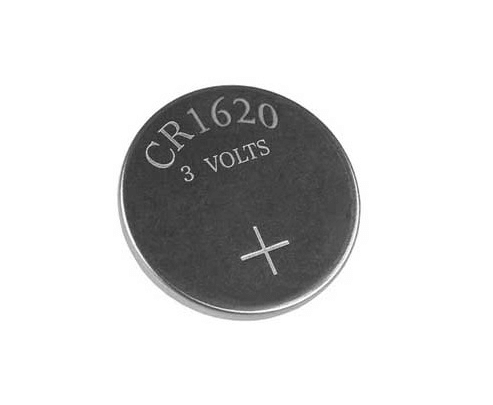
Figure 1: CR1620 Battery
Features and Specifications of CR1620 Battery
• Diameter: 16.0 mm
• Thickness: 2.0 mm
• Voltage: 3 volts
• Capacity: About 70 mAh, but it can differ a bit based on the maker and the exact battery type.
• Chemistry: Lithium/Manganese Dioxide (Li/MnO2), a popular choice for coin cell batteries because it's stable and offers a consistent voltage.
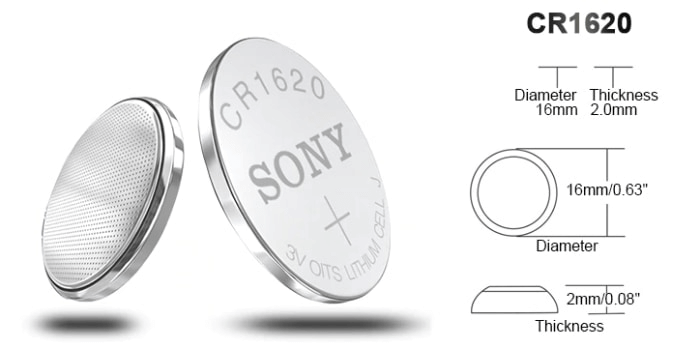
Figure 2: CR1620 Battery Diameter
Voltage, Capacity, Discharge Rate and Shelf Life of CR1620 Battery
|
Characteristic |
Details |
|
Voltage |
|
|
Standard Voltage |
3 volts (nominal), standard for lithium
coin cells using lithium as the anode |
|
Operating Voltage Range |
Starts at 3.2 volts when fully charged,
drops to around 2 volts as the battery depletes |
|
Capacity |
|
|
Nominal Capacity |
70 to 100 milliampere-hours (mAh) |
|
Factors Affecting Capacity |
Discharge current, energy demands of the device,
operating temperature, and battery age |
|
Discharge Rate |
|
|
Standard Discharge Current |
Discharge current is around 0.1 mA |
|
Pulse Discharge |
For devices needing short bursts of
higher power, such as RF transmissions in fobs, the battery can handle pulse
discharges at higher currents, often reaching a few milliamperes. |
|
Shelf Life |
Up to 10 years |
Chemical Composition of CR1620 Battery
Cathode (Positive Electrode)
Material: Manganese dioxide (MnO2)
Function: Accepts electrons during discharge, acting as the oxidizing agent.
Characteristics: Provides stable voltage and high energy density.
Anode (Negative Electrode)
Material: Lithium metal (Li)
Function: Donates electrons during discharge, acting as the reducing agent.
Characteristics: Lightweight with high electrochemical potential and contributing to the battery's high energy density.
Electrolyte
Material: Organic solvent with dissolved lithium salt, such as lithium perchlorate (LiClO4) in propylene carbonate (PC) and 1,2-dimethoxyethane (DME).
Function: Facilitates lithium ion movement between the cathode and anode during charge and discharge.
Characteristics: Maintains ionic conductivity and stability across a wide temperature range.
Separator
Material: Microporous polyethylene or polypropylene film.
Function: Prevents direct contact between the anode and cathode to avoid short circuits while allowing ion flow.
Characteristics: Doesn't react chemically and strong enough to handle inside pressures.
Housing
Material: Stainless steel.
Function: Encases the internal components, providing structural integrity and external protection.
Characteristics: Corrosion-resistant and durable.
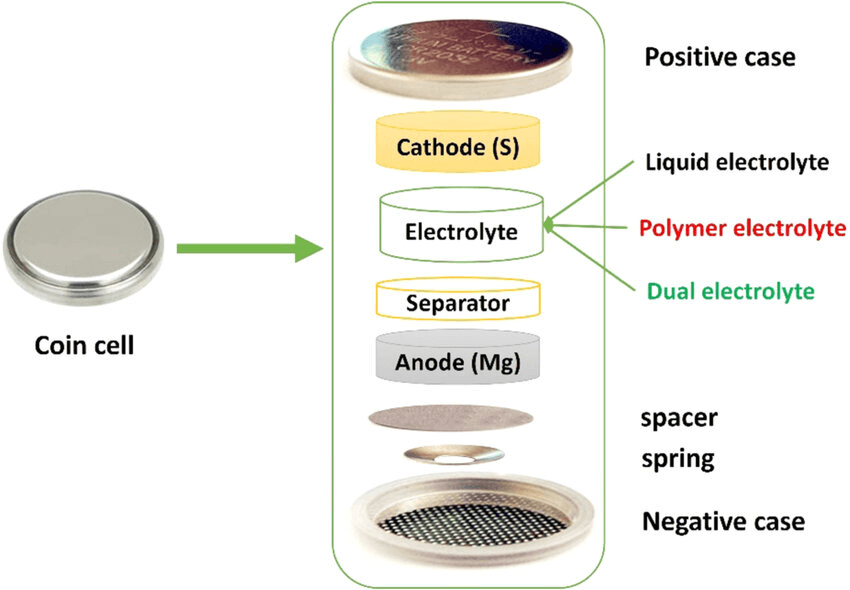
Figure 3: 2Chemical Composition of CR1620 Battery
Comparison with Similar Batteries: VL1620, BR1620, LiR1620 and ML1620
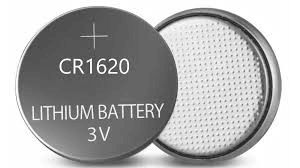
Figure 4: CR1620 Battery
VL1620 vs. CR1620
The VL1620 battery can be used in place of the CR1620 battery because they both have the same voltage.
|
Feature |
CR1620 |
VL1620 |
|
Chemistry |
Lithium manganese dioxide |
Lithium vanadium pentoxide |
|
Voltage |
3 volts |
3 volts |
|
Capacity |
70 to 80 mAh |
20 to 30 mAh |
|
Rechargeability |
Non-rechargeable |
Rechargeable |
|
Applications |
Watches, calculators, small electronic
devices |
Backup power for memory, real-time clocks
in electronics |
|
Cost and Availability |
Easier to find and cheaper due to disposable
nature |
Less commonly found, specific
applications and rechargeable design |
|
Shelf Life and Stability |
10 years or more. Very stable under a wide range of environmental conditions |
5 to 10 years (depends on manufacturer
and storage conditions). Good stability under normal usage conditions |
BR1620 vs. CR1620
|
Feature |
CR1620 |
BR1620 |
|
Chemistry |
Lithium manganese dioxide |
Carbon monofluoride lithium |
|
Voltage |
3 volts |
3 volts, may work at slightly lower
voltage |
|
Capacity |
70 to 80 mAh |
65 to 70 mAh, depends on maker and model |
|
Rechargeability |
Non-rechargeable |
Non-rechargeable or one-time use |
|
Operating Temperature |
Works in varied, but slightly narrower,
temperatures |
Works in wider and extreme temperatures |
|
Cost and Availability |
Cheaper, used more often. Easier to find in stores and online |
A bit more expensive, used less often. Harder to find, sold by special shops or online |
|
Shelf Life and Stability |
Higher energy and stable in many
conditions |
More stable over its life, especially in
heat |
LiR1620 vs. CR1620
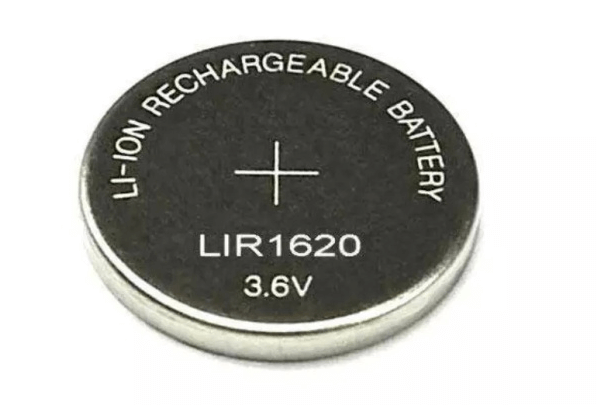
Figure 5: LiR1620 Battery
Chemistry
CR1620: This is a non-rechargeable lithium manganese dioxide (Li/MnO2) battery. It provides stable voltage and has a high energy density, usually around 3 volts.
LiR1620: This is a rechargeable lithium-ion battery. It also offers 3 volts but can be recharged multiple times.
Performance and Voltage
CR1620: It delivers a consistent 3 volts until it’s almost empty. The voltage stays steady throughout the battery’s life until it drops suddenly when it's nearly used up.
LiR1620: It provides about 3 volts. However, the voltage might vary slightly depending on the charge level since it’s rechargeable.
Capacity and Longevity
CR1620: These batteries have a higher initial capacity, around 70 to 100 milliampere-hours (mAh).
LiR1620: The capacity is lower, around 40 to 70 mAh, but the ability to recharge extends its useful life.
Rechargeability and Self-Discharge Rates
CR1620: Not rechargeable and must be replaced once it’s used up. Very low, losing only about 1% per year, making it good for long-term use without frequent replacements.
LiR1620: Can be recharged up to 500 times, good for devices that are used a lot and where changing batteries often is inconvenient. Loses about 2-3% of its charge per month, though battery technology improvements help reduce this for long-term storage.
Cost
CR1620: Cheaper per unit but might cost more over time due to frequent replacements.
LiR1620: More expensive but can be cheaper in the long run if used in devices that need frequent battery changes and recharging.
Applications
CR1620: Great for devices needing long shelf life and stable voltage with low power use over a long time, like watches, calculators, and memory backup systems.
LiR1620: Great for devices that are used often and can be easily recharged, such as Bluetooth trackers, small medical devices, and wearable electronics.
ML1620 vs. CR1620
Chemistry
ML1620: The "ML" indicates it is made of manganese and lithium. Lithium Manganese Dioxide (Li/MnO₂)
CR1620: The "CR" means it uses lithium manganese dioxide. Lithium Manganese Dioxide (Li/MnO₂)
Voltage
Both ML1620 and CR1620 batteries have a nominal voltage of about 3 volts.
Capacity
CR1620: These batteries have a capacity of 70 to 100 milliamp hours (mAh).
ML1620: Rechargeable batteries like these have a lower capacity because the recharge mechanism takes up space.
Rechargeability
ML1620: Can be recharged many times.
CR1620: Designed for single-use and cannot be recharged.
Lifespan and Performance
CR1620: Has a longer single-use life with stable output over time.
ML1620: Can be recharged but may have reduced capacity after many recharges.
Discharge Rate
CR1620: Ideal for low-drain devices and maintaining stable voltage for a long time. Not suitable for high-drain situations.
ML1620: Can handle higher discharge rates better than non-rechargeable ones and delivering higher bursts of power when required. Suitable for devices with varying power needs.
Comparison of Close Alternatives: CR1616 and CR1632
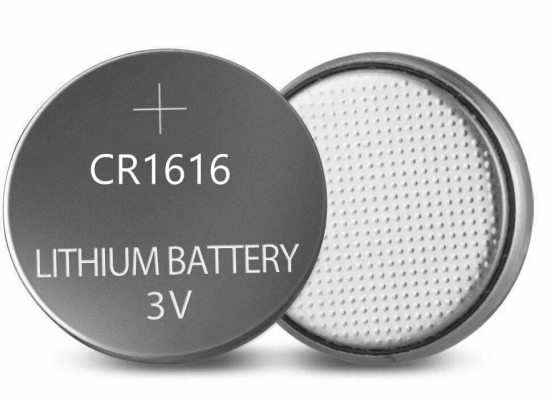
Figure 6: CR1616 Battery
CR1616 vs. CR1620
|
Battery Type |
Diameter (mm) |
Thickness (mm) |
Capacity (mAh) |
|
CR1616 |
16 |
1.6 |
50-55 |
|
CR1620 |
16 |
2.0 |
70-100 |
Firstly, the CR1620 is thicker than the CR1616, providing more internal volume. This extra volume allows the CR1620 to have a higher capacity than the CR1616.
In terms of battery capacity, CR1620 battery has a higher capacity than the CR1616 battery. This means the CR1620 can last longer and keep devices like digital watches and car keys powered for a longer time.
In terms of voltage, both batteries provide 3 volts. The main difference is how long they last because of their capacity.
In terms of size fit, both batteries have the same diameter, but the CR1620 is thicker. Devices made for the thinner CR1616 might not fit the thicker CR1620. Using a CR1616 in a device made for a CR1620 might make the battery fit loosely.
CR1632 vs. CR1620
|
Feature |
CR1632 |
CR1620 |
|
Diameter |
16
mm |
16
mm |
|
Thickness |
3.2
mm |
2.0
mm |
|
Voltage |
3
volts |
3
volts |
|
Capacity |
130-140
mAh |
70-78
mAh |
Devices designed for a CR1620 may not accommodate the thicker CR1632 and can cause the battery compartment to not close properly or put stress on internal components. Using a CR1620 in a slot designed for a CR1632 might result in a loose fit, leading to unreliable connections and intermittent power issues.
The CR1632 battery has a bigger capacity, making it good for devices that need more power and last longer like high-end digital watches or fitness trackers. The CR1620 battery is a bit thinner and is used in small devices where space is tight like slim remote controls or compact medical devices.
Due to the size differences, it’s important to use the battery specified by the device manufacturer. Using a CR1620 in a device designed for a CR1632 can cause poor contact and unreliable power. Using a CR1632 in a device meant for a CR1620 can cause mechanical strain or prevent the battery compartment from closing properly.
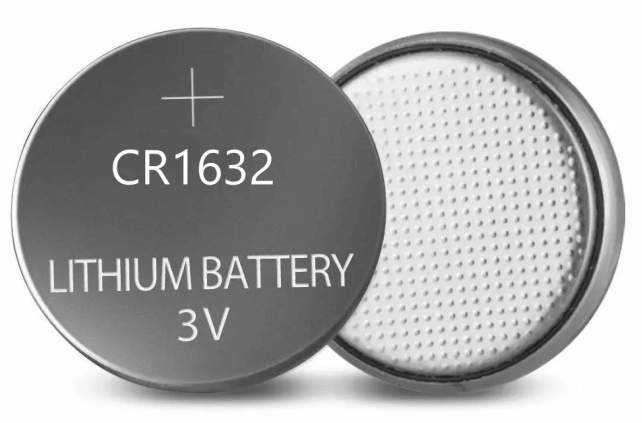
Figure 7: CR1632 Battery
CR1620 Battery Safety Issues
The primary danger of CR1620 batteries is swallowing them. Their small size and shiny appearance attract children and pets. Ingesting these batteries can cause serious injuries or even death. The battery’s electrical charge can cause a chemical reaction that burns through body tissues leading to severe internal injuries within hours.
To reduce risks, manufacturers and regulators have developed safer packaging. Some packages have dual-release mechanisms or need extra strength or coordination to open and making them difficult for young children to access.
Conclusion
The CR1620 battery is a great example of advanced design and practical use in small electronic devices. It offers steady voltage, high energy, and long shelf life, showing its quality and versatility in many uses. Comparing it with batteries like the VL1620, BR1620, LiR1620, ML1620, CR1616, and CR1632 highlights its cost-effectiveness, availability, and non-rechargeable nature, making it a reliable choice for both buyers and manufacturers. As technology grows, the CR1620 proves the importance of dependable power sources in portable electronics, emphasizing how detailed battery comparisons help guide consumer decisions and technological progress.
Frequently Asked Questions [FAQ]
1. Can I replace a CR1620 battery with a CR1632?
No, you cannot replace a CR1620 battery with a CR1632. Although both are 3V lithium coin cells, the CR1632 is thicker (3.2 mm) compared to the CR1620 (2.0 mm). This difference in thickness could prevent the battery compartment from closing properly, and there might be issues with electrical contact.
2. Is CR1620 the same as CR2032?
No, the CR1620 and CR2032 batteries are not interchangeable. The CR2032 battery is both wider and thicker (20 mm in diameter and 3.2 mm thick) compared to the CR1620 (16 mm in diameter and 2.0 mm thick). Their physical dimensions differ, meaning they cannot be used interchangeably without modification or risk of damage to the device.
3. Is CR1616 the same as CR1620?
No, the CR1616 and CR1620 are not the same. While both batteries have the same diameter of 16 mm, they differ in thickness: the CR1616 is 1.6 mm thick, and the CR1620 is 2.0 mm thick. This small difference in size changes how they fit in devices, so they can't be swapped with each other.
4. Is a CR1620 battery the same as CR2016?
No, a CR1620 battery is not the same as a CR2016. Even though both batteries are 20 mm wide, the CR1620 is 2.0 mm thick, and the CR2016 is 1.6 mm thick. Because of their different thicknesses, they might not fit properly in devices that need an exact size.
5. What devices use the 1620 battery?
The CR1620 battery is often used in small electronic devices that need a compact and long-lasting power source. It is commonly found in calculators, car and garage remote controls, digital thermometers, heart rate monitors, small toys, and portable gadgets. Its small size is perfect for devices that need a thin battery to save space and still work reliably.